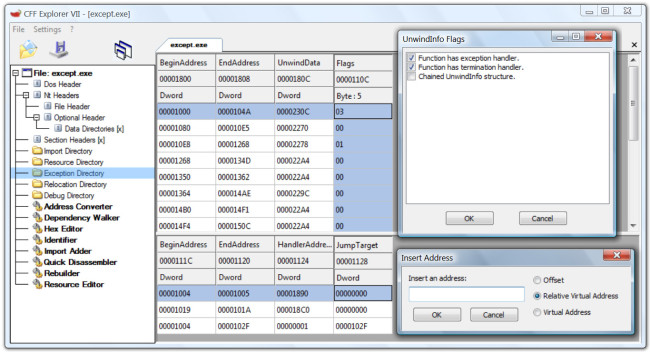I updated the scripting language of the old CFF Explorer which now provides a function to automatically create reports of .NET metadata tables. The function is called LogPrintStruct and is to be used along with the logging functions the scripting provides. Here’s a small script you can find in the “Scripts” directory of the CFF Explorer which creates a report of all .NET tables contained in an assembly:
[cc lang=”lua”]– this script generates a report of a PE’s .NET metadata tables.
filename = GetOpenFile(“Open…”, “All\n*.*\nexe\n*.exe\ndll\n*.dll\n”)
if filename == null then
return
end
hPE = OpenFile(filename)
if hPE == null then
return
end
if GetOffset(hPE, PE_DotNETDirectory) == null then
MsgBox(“The current is not a valid .NET assembly.”, “Error”, MB_ICONEXCLAMATION)
end
repname = GetSaveFile(“Save Report As..”, “Text File\n*.txt\n”)
if repname == null then
return
end
hReport = CreateLog(repname)
if hReport == null then
return
end
fieldsToLog = {
PE_MetaDataTable_Module,
PE_MetaDataTable_TypeRef,
PE_MetaDataTable_TypeDef,
PE_MetaDataTable_Field,
PE_MetaDataTable_Method,
PE_MetaDataTable_Param,
PE_MetaDataTable_InterfaceImpl,
PE_MetaDataTable_MemberRef,
PE_MetaDataTable_Constant,
PE_MetaDataTable_CustomAttribute,
PE_MetaDataTable_FieldMarshal,
PE_MetaDataTable_DeclSecurity,
PE_MetaDataTable_ClassLayout,
PE_MetaDataTable_FieldLayout,
PE_MetaDataTable_StandAloneSig,
PE_MetaDataTable_EventMap,
PE_MetaDataTable_Event,
PE_MetaDataTable_PropertyMap,
PE_MetaDataTable_Property,
PE_MetaDataTable_MethodSemantics,
PE_MetaDataTable_MethodImpl,
PE_MetaDataTable_ModuleRef,
PE_MetaDataTable_TypeSpec,
PE_MetaDataTable_ImplMap,
PE_MetaDataTable_FieldRVA,
PE_MetaDataTable_Assembly,
PE_MetaDataTable_AssemblyProcessor,
PE_MetaDataTable_AssemblyOS,
PE_MetaDataTable_AssemblyRef,
PE_MetaDataTable_AssemblyRefProcessor,
PE_MetaDataTable_AssemblyRefOS,
PE_MetaDataTable_File,
PE_MetaDataTable_ExportedType,
PE_MetaDataTable_ManifestResource,
PE_MetaDataTable_NestedClass,
PE_MetaDataTable_GenericParam,
PE_MetaDataTable_MethodSpec,
PE_MetaDataTable_GenericParamConstraint
}
fieldNames = {
“Module”,
“TypeRef”,
“TypeDef”,
“Field”,
“Method”,
“Param”,
“InterfaceImpl”,
“MemberRef”,
“Constant”,
“CustomAttribute”,
“FieldMarshal”,
“DeclSecurity”,
“ClassLayout”,
“FieldLayout”,
“StandAloneSig”,
“EventMap”,
“Event”,
“PropertyMap”,
“Property”,
“MethodSemantics”,
“MethodImpl”,
“ModuleRef”,
“TypeSpec”,
“ImplMap”,
“FieldRVA”,
“Assembly”,
“AssemblyProcessor”,
“AssemblyOS”,
“AssemblyRef”,
“AssemblyRefProcessor”,
“AssemblyRefOS”,
“File”,
“ExportedType”,
“ManifestResource”,
“NestedClass”,
“GenericParam”,
“MethodSpec”,
“GenericParamConstraint”
}
LogPrint(hReport, “.NET metadata tables report for \”” .. filename .. “\”\n\n”)
loggedTables = 0
for i = 0, #fieldsToLog – 1 do
if GetOffset(hPE, fieldsToLog[i]) != null then
if loggedTables > 0 then
LogPrint(hReport, “\n\n\n”)
end
LogPrint(hReport, fieldNames[i] .. ” Table\n”)
LogPrint(hReport, “———————————————\n\n”)
LogPrintStruct(hPE, hReport, fieldsToLog[i])
loggedTables = loggedTables + 1
end
end
— Open the report?
CloseLog(hReport)
nRet = MsgBox(“Open report file?”, “.NET Tables Report”, MB_ICONQUESTION | MB_YESNO)
if nRet == IDYES then
ExecuteAppAndWait(@”C:\Windows\System32\notepad.exe”, GetShortPathName(repname))
end[/cc]
A generated report file looks like this:
[cc lang=”asm”].NET metadata tables report for “K:\Explorer Suite\Setup\Signature Explorer.exe”
Module Table
———————————————
1.
Generation: 0
Name: 1 (Signature Explorer.exe)
Mvid: 1
EncId: 0
EncBaseId: 0
TypeRef Table
———————————————
1.
ResolutionScope: 6
Name: 18 (Control)
Namespace: 20 (System.Windows.Forms)
2.
ResolutionScope: A
Name: 35 (Enum)
Namespace: 3A (System)
3.
ResolutionScope: 6
Name: 41 (Button)
Namespace: 20 (System.Windows.Forms)
4.
ResolutionScope: 6
Name: 48 (Form)
Namespace: 20 (System.Windows.Forms)
5.
ResolutionScope: A
Name: 4D (Object)
Namespace: 3A (System)
6.
ResolutionScope: A
Name: 54 (ValueType)
Namespace: 3A (System)
etc.[/cc]
I included this new feature because many developers asked me to. Reading the generated report files is much easier than manually reading the raw .NET format. The current scripting system won’t be implemented in the newer CFF Explorer, I only inserted this new feature because it will take me much more time to release the newer CFF Explorer.
Thanks to CodeRipper for signalling a corrupted .NET assembly which caused the CFF Explorer to crash when opening it. I improved the integrity checks.


